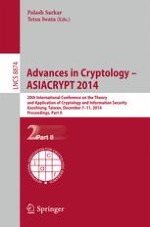The two-volume set LNCS 8873 and 8874 constitutes the refereed proceedings of the 20th International Conference on the Theory and Applications of Cryptology and Information Security, ASIACRYPT 2014, held in Kaoshiung, Taiwan, in December 2014. The 55 revised full papers and two invited talks presented were carefully selected from 255 submissions. They are organized in topical sections on cryptology and coding theory; authenticated encryption; symmetric key cryptanalysis; side channel analysis; hyperelliptic curve cryptography; factoring and discrete log; cryptanalysis; signatures; zero knowledge; encryption schemes; outsourcing and delegation; obfuscation; homomorphic cryptography; secret sharing; block ciphers and passwords; black-box separation; composability; multi-party computation.
